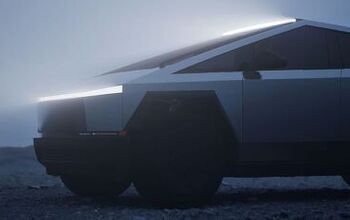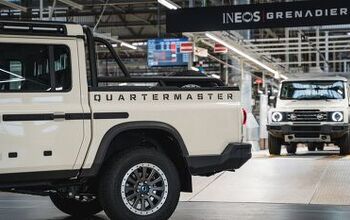Gas War: Automakers Continue Begging Government for EV Incentives

On Monday, General Motors, Ford, Stellantis, and Toyota Motor North America reportedly asked the United States Congress to lift the existing cap on the $7,500 federal tax credit for electric vehicles. Though automakers petitioning the government for free money is hardly new business.
In 2009, the Obama administration set aside $2.4 billion in funding to produce more efficient batteries intended for hybrid cars. The grants came hot on the heels of industry bailouts launched by Bush during the Great Recession (the first one) and the establishment of the EV tax credit scheme we know today. The Car Allowance Rebate System (Cash4Clunkers) was also established in 2009. Though the industry doesn’t limit itself to taking money tied exclusively to allegedly environmental schemes or industrial bankruptcy. During the earliest days of the Trump administration, just about every domestic automaker went to the White House to ask that the government request that vehicle fuel-efficiency rules be revised (softened) to account for the growing popularity of larger vehicles. However several abandoned any public support after media coverage of the fueling rollback became unfavorable.
The point is automakers are almost always begging for money, even when they claim they’re above it. Case in point, Toyota actually opposed the Biden administration’s proposal to add $4,500 in incentives atop union-made vehicles. Toyota doesn’t have any union-backed factories in the United States and even launched an ad campaign opposing the plan. But its leadership is only too happy to sign onto a letter asking that the government expand the number of EVs automakers are allowed to produce before the money dries up.
According to Automotive News, the letter was penned by GM CEO Mary Barra, Ford’s Jim Farley, Stellantis’ Carlos Tavares, and Toyota North America CEO Tetsuo Ogawa. The group pledged to invest more than $170 billion through 2030 to ensure that EV development and production were on pace to see the U.S. transition over to electrified transportation.
From AN:
The $7,500 tax credit phases out after a manufacturer hits 200,000 vehicles sold. Both GM and Tesla have already hit the cap and are no longer eligible for the consumer tax credits.
“We ask that the per-(automaker) cap be removed, with a sunset date set for a time when the EV market is more mature,” the automakers said in the letter.
“Recent economic pressures and supply chain constraints are increasing the cost of manufacturing electrified vehicles which, in turn, puts pressure on the price to consumers.”
The letter comes amid growing concerns among auto industry executives that the window is closing for U.S. Congress to extend electric vehicle tax credits, since Republicans could retake control of one or both houses of Congress next year.
Last week, Ford Executive Chairman Bill Ford made an unannounced trip to Capitol Hill to make the case for extending the tax credit.
Worse still, battery prices look poised to skyrocket as the raw materials necessary for their production become harder to procure. Asia, which dominates the world’s battery production, also seems to be concerned with domestic production — potentially making thing cells even harder to come by in the West.
The Biden administration, along with top-ranking Democrats, has suggested raising EV payouts to $12,500 per vehicle (that’s atop the suggested $4,500 for union-backed labor) and raising the or even resetting the existing vehicle quota. The president has likewise recommended a 30-percent credit for commercial electric vehicles and a $4,000 used EV tax credit that’s refundable at the point of sale.
The only automaker that seems to have come out overtly against the plan is Tesla. CEO Elon Musk has repeatedly stated that tying incentives to unions is a blatantly political act and that he believes the EV market will never mature if the government continues subsidizing it with taxes. He suggested leaving the caps and quotas as is to allow all businesses to have an equal advantage, noting that some companies already squandered earlier advancements in electrification (an obvious jab at General Motors’ EV1 program).
In April, Senator Joe Manchin — a Democrat who always seems to be the party’s dissenting voice — expressed concerns that extending EV tax credits may ultimately end up advantaging Chinese battery suppliers while throwing free money at U.S. automakers for doing nothing more than sticking to their existing production plans.
“There’s a waiting list for EVs right now with the fuel price at $4.00 [per gallon]. But they still want us to throw $5,000 or $7,000 or $12,000 credit to buy electric vehicles. It makes no sense to me whatsoever,” Manchin said at the time. “When we can’t produce enough product for the people that want it and we’re still going to pay them to take it — it’s absolutely ludicrous in my mind.”
Republicans, which currently appear poised to take a majority in Congress come November, have signaled they’re less interested in EV tax credits. Instead, they want to focus on how to lower U.S. energy prices that have continued to swell since Manchin publicly voiced his opinion two months ago.
My guess is that will be easier said than done considering the current state of the economy. But the previous industry assumption that EVs would reach financial parity with internal combustion vehicles by 2025 hasn’t gone according to plan either. If anything, the raw materials necessary for battery production only seem to be getting more expensive — with the assumption being that this will result in EVs carrying higher price tags for years to come.
[Image: JL IMAGES/Shutterstock]

A staunch consumer advocate tracking industry trends and regulation. Before joining TTAC, Matt spent a decade working for marketing and research firms based in NYC. Clients included several of the world’s largest automakers, global tire brands, and aftermarket part suppliers. Dissatisfied with the corporate world and resentful of having to wear suits everyday, he pivoted to writing about cars. Since then, that man has become an ardent supporter of the right-to-repair movement, been interviewed on the auto industry by national radio broadcasts, driven more rental cars than anyone ever should, participated in amateur rallying events, and received the requisite minimum training as sanctioned by the SCCA. Handy with a wrench, Matt grew up surrounded by Detroit auto workers and managed to get a pizza delivery job before he was legally eligible. He later found himself driving box trucks through Manhattan, guaranteeing future sympathy for actual truckers. He continues to conduct research pertaining to the automotive sector as an independent contractor and has since moved back to his native Michigan, closer to where the cars are born. A contrarian, Matt claims to prefer understeer — stating that front and all-wheel drive vehicles cater best to his driving style.
More by Matt Posky
Latest Car Reviews
Read moreLatest Product Reviews
Read moreRecent Comments
- Lou_BC This is less harmful to one's re-election chances than harder driver's licence exams and making people re-test.
- 28-Cars-Later Probably should investigate the buyers too, maybe a basic psych eval?
- 28-Cars-Later "Despite nobody really digging the moniker, Honda has told Autocar that it only plans on changing the name of the model in China (as part of a more comprehensive facelift) because that’s where they’re having the most trouble and anticipated the largest sales volumes.""Customers in China just can’t pronounce it,” explained the source."So the Chinese are class A customers but frack the rest of y'all we don't care what you think or can understand?
- ToolGuy Is a Tesla store the same as a Tesla gallery? 16955 Chesterfield Airport Road is a gallery. 5711 S Lindbergh Blvd is a store. I wonder if anyone knows how far away those two locations are from each other. I wonder if Tesla's website shows vehicles in inventory. I wonder if there is a distance dropdown. So many questions.
- 28-Cars-Later Zerohedge reported something similar in Belgium with the reasoning being the Chinese are flooding Europe with EVs in the early innings of a trade war. For Tesla any guess is a good one but my money is on BEV saturation has been reached.


































Comments
Join the conversation
EV development is currently subsidized by ICE sales. Yet, GM and other manufacturers are talking about spinning off EV from ICE production. In Wall Street parlance, "freeing up cash for potential dividends". Let Wall Street finance EVs. While I'm on my soap box, once government checks stop flowing, unemployment will drop like a rock. Also, my state is using left over Federal COVID money to finance its underfunded pension plan. Yet, the big city I live next to only has 1100 of 1600 police officers on duty. Yet, five people were murdered this past week. But guess where the city's surplus COVID money is going to.....yep, new bike cycle lanes. Sorry Sleepy Joe, but tooo much Government money is contributing to inflation and fiscal mismanagement. The party is over. Time to balance your purse book.
So government created an artificial demand by subsidizing the price of EVs over other alternative fuels. Manufacturers have bought in. Now everybody realizes that it won't catch on without the subsidy, thus proving what we knew all along, that people aren't going to drop ICE unless the replacement is similar price? I'm talking purchase cost. If people thought about operating cost when buying a vehicle, trucks wouldn't be so popular.